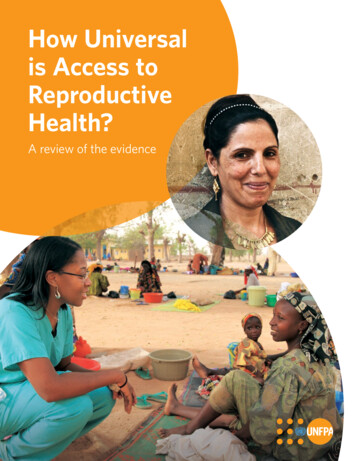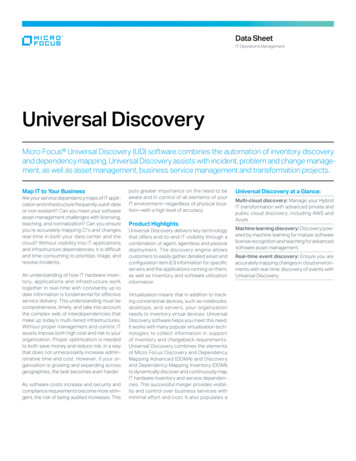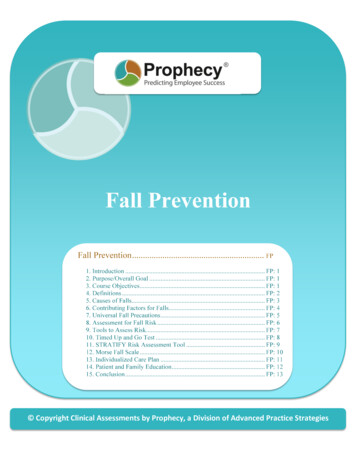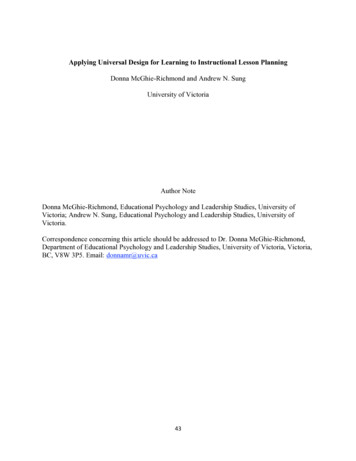
Transcription
How Universalis Access toReproductiveHealth?A review of the evidenceCover
Copyright UNFPA 2010September 2010Publication available at: 6526The designations employed and the presentation of the material in this publicationdo not imply the expression of any opinion whatsoever on the part of UNFPAconcerning the legal status of any country, territory, city or area, or of its authorities,or concerning the delimitation of its frontiers or boundaries.
How Universal is Access toReproductive Health?A review of the evidence
CONTENTSPREFACE. . . . . . . . . . . . . . . . . . . . . . . . . . . . . . . . . . . . . . . . . . . . . . . . . . . . . . . . . . . . . . . . . . . . . . . . . . . . . . . . . . . . . . . . . . . . . . 5Executive Summary. . . . . . . . . . . . . . . . . . . . . . . . . . . . . . . . . . . . . . . . . . . . . . . . . . . . . . . . . . . . . . . . . . . . . . . . . . . . . . . . 6Chapter 1. Reproductive Health and the Millennium Development Goals. . . . . . . . . . . . . . . . . . . . 7How this report is organized . . . . . . . . . . . . . . . . . . . . . . . . . . . . . . . . . . . . . . . . . . . . . . . . . . . . . . . . . . . . . . . . . . . . . . . . . . . . . . . . 8Chapter 2. Measuring Progress. . . . . . . . . . . . . . . . . . . . . . . . . . . . . . . . . . . . . . . . . . . . . . . . . . . . . . . . . . . . . . . . . . . 9Reproductive health indicators and data availability . . . . . . . . . . . . . . . . . . . . . . . . . . . . . . . . . . . . . . . . . . . . . . . . . . . . . . . . . . . . . . 9Understanding averages and uncovering disparities . . . . . . . . . . . . . . . . . . . . . . . . . . . . . . . . . . . . . . . . . . . . . . . . . . . . . . . . . . . . . . 10Three key indicators for reproductive health . . . . . . . . . . . . . . . . . . . . . . . . . . . . . . . . . . . . . . . . . . . . . . . . . . . . . . . . . . . . . . . . . . 10Chapter 3. Global and Regional Levels and Trends. . . . . . . . . . . . . . . . . . . . . . . . . . . . . . . . . . . . . . . . . . . . 12Adolescent birth rates: global progress slows . . . . . . . . . . . . . . . . . . . . . . . . . . . . . . . . . . . . . . . . . . . . . . . . . . . . . . . . . . . . . . . . . . . 12Wide disparities in adolescent birth rates among regions . . . . . . . . . . . . . . . . . . . . . . . . . . . . . . . . . . . . . . . . . . . . . . . . . . . . . . . . . 12Significant gaps in family planning demand and use . . . . . . . . . . . . . . . . . . . . . . . . . . . . . . . . . . . . . . . . . . . . . . . . . . . . . . . . . . . . . 14Persistent regional disparities in unmet need for family planning . . . . . . . . . . . . . . . . . . . . . . . . . . . . . . . . . . . . . . . . . . . . . . . . . . . 15Latin America and the Caribbean: a complicated picture . . . . . . . . . . . . . . . . . . . . . . . . . . . . . . . . . . . . . . . . . . . . . . . . . . . . . . . . . 17The Commonwealth of Independent States: additional data required . . . . . . . . . . . . . . . . . . . . . . . . . . . . . . . . . . . . . . . . . . . . . . . . 17Southern Asia: increased contraceptive prevalence and large country influence . . . . . . . . . . . . . . . . . . . . . . . . . . . . . . . . . . . . . . . . . 17Sub-Saharan Africa: low contraceptive use and high unmet need . . . . . . . . . . . . . . . . . . . . . . . . . . . . . . . . . . . . . . . . . . . . . . . . . . . 18Stymied progress in satisfying demand for family planning . . . . . . . . . . . . . . . . . . . . . . . . . . . . . . . . . . . . . . . . . . . . . . . . . . . . . . . . 18Chapter 4. Trends in Sub-Saharan Africa: Disparities and Inequalities. . . . . . . . . . . . . . . . . . . . . . 20Adolescent birth rates: widening disparities within countries . . . . . . . . . . . . . . . . . . . . . . . . . . . . . . . . . . . . . . . . . . . . . . . . . . . . . . 20Contraceptive use: influenced by wealth, education, residence and age . . . . . . . . . . . . . . . . . . . . . . . . . . . . . . . . . . . . . . . . . . . . . . . 22Disparities in unmet need for family planning . . . . . . . . . . . . . . . . . . . . . . . . . . . . . . . . . . . . . . . . . . . . . . . . . . . . . . . . . . . . . . . . . 24Least progress among groups of women that lag farthest behind . . . . . . . . . . . . . . . . . . . . . . . . . . . . . . . . . . . . . . . . . . . . . . . . . . . . 24Diversity at the country level: Madagascar and the United Republic of Tanzania . . . . . . . . . . . . . . . . . . . . . . . . . . . . . . . . . . . . . . . 27Satisfied demand for family planning in sub-Saharan Africa: still the lowest in the world . . . . . . . . . . . . . . . . . . . . . . . . . . . . . . . . . 27Chapter 5. Conclusion. . . . . . . . . . . . . . . . . . . . . . . . . . . . . . . . . . . . . . . . . . . . . . . . . . . . . . . . . . . . . . . . . . . . . . . . . . . . 29NOTES AND REFERENCES. . . . . . . . . . . . . . . . . . . . . . . . . . . . . . . . . . . . . . . . . . . . . . . . . . . . . . . . . . . . . . . . . . . . . . . . . . . . . 30ANNEXESAnnex I. Millennium Development Goals, targets and indicators . . . . . . . . . . . . . . . . . . . . . . . . . . . . . . . . . . . . . . . . . . . . . . . . . . 31Annex II. Recent country estimates for three reproductive health indicators . . . . . . . . . . . . . . . . . . . . . . . . . . . . . . . . . . . . . . . . . . . 34Annex III. Trends and disparities in reproductive health for selected countries in sub-Saharan Africa . . . . . . . . . . . . . . . . . . . . . . . . 39co n t e n ts3
TABLESTable 1. Millennium Development Goal 5 targets and indicators . . . . . . . . . . . . . . . . . . . . . . . . . . . . . . . . . . . . . . . . . . . . . . . . . . . . 7Table 2. Adolescent birth rate by region, 1990, 2000 and 2007 . . . . . . . . . . . . . . . . . . . . . . . . . . . . . . . . . . . . . . . . . . . . . . . . . . . . 13Table 3. Contraceptive prevalence rate and unmet need for family planning, by region, 1990, 2000 and around 2007 . . . . . . . . . . 16Table 4. Changes in key reproductive health indicators by country and type of change . . . . . . . . . . . . . . . . . . . . . . . . . . . . . . . . . . 26FIGURESFigure 1. Trend in global adolescent birth rate, 1990, 2000 and around 2007 . . . . . . . . . . . . . . . . . . . . . . . . . . . . . . . . . . . . . . . . . 12Figure 2. Global trends in contraceptive prevalence and unmet need for family planning, 1990, 2000 and around 2007 . . . . . . . . . 15Figure 3. Trends in proportion of demand satisfied for family planning, by region, 1990, 2000 and around 2007 . . . . . . . . . . . . . . 19Figure 4. Adolescent birth rates by background characteristics in 24 sub-Saharan African countries, at most recentsurvey, 1998-2008 . . . . . . . . . . . . . . . . . . . . . . . . . . . . . . . . . . . . . . . . . . . . . . . . . . . . . . . . . . . . . . . . . . . . . . . . . . . . . . . . . . . . . 20Figure 5. Trends in adolescent birth rates by background characteristics in 24 sub-Saharan African countries withtwo consecutive surveys, 1988-2003 and 1998-2008 . . . . . . . . . . . . . . . . . . . . . . . . . . . . . . . . . . . . . . . . . . . . . . . . . . . . . . . . . . . 21Figure 6. Contraceptive prevalence by background characteristics for 24 sub-Saharan African countries at most recent survey,1998-2008 . . . . . . . . . . . . . . . . . . . . . . . . . . . . . . . . . . . . . . . . . . . . . . . . . . . . . . . . . . . . . . . . . . . . . . . . . . . . . . . . . . . . . . . . . . 21Figure 7. Trends in contraceptive prevalence by background characteristics for 24 sub-Saharan African countries with twoconsecutive surveys, 1994-2003 and 1998-2008 . . . . . . . . . . . . . . . . . . . . . . . . . . . . . . . . . . . . . . . . . . . . . . . . . . . . . . . . . . . . . . 22Figure 8. Trends in contraceptive prevalence rate by age groups for 24 sub-Saharan African countries with two consecutivesurveys, 1994-2003 and 1998-2008 . . . . . . . . . . . . . . . . . . . . . . . . . . . . . . . . . . . . . . . . . . . . . . . . . . . . . . . . . . . . . . . . . . . . . . . 23Figure 9. Unmet need for family planning by background characteristics in 22 sub-Saharan African countries at most recentsurvey, 1998-2008 . . . . . . . . . . . . . . . . . . . . . . . . . . . . . . . . . . . . . . . . . . . . . . . . . . . . . . . . . . . . . . . . . . . . . . . . . . . . . . . . . . . . . 23Figure 10. Trends in unmet need for family planning by background characteristics in 22 sub-Saharan African countries withtwo consecutive surveys, 1986-2003 and 1998-2008 . . . . . . . . . . . . . . . . . . . . . . . . . . . . . . . . . . . . . . . . . . . . . . . . . . . . . . . . . . . 24Figure 11. Trends in unmet need for family planning by age group for 22 sub-Saharan African countries with two consecutivesurveys, 1986-2003 and 1998-2008 . . . . . . . . . . . . . . . . . . . . . . . . . . . . . . . . . . . . . . . . . . . . . . . . . . . . . . . . . . . . . . . . . . . . . . . 25Figure 12. Trends in proportion of demand satisfied for family planning by background characteristics in 22 sub-Saharan Africancountries with two consecutive surveys, 1988-2003 and 1998-2008 . . . . . . . . . . . . . . . . . . . . . . . . . . . . . . . . . . . . . . . . . . . . . . .28MAPSMap 1. Adolescent birth rates by country, most recent estimates . . . . . . . . . . . . . . . . . . . . . . . . . . . . . . . . . . . . . . . . . . . . . . . . . . . 14Map 2. Contraceptive prevalence, by country, most recent estimates . . . . . . . . . . . . . . . . . . . . . . . . . . . . . . . . . . . . . . . . . . . . . . . . 18Map 3. Unmet need for family planning, by country, most recent estimates . . . . . . . . . . . . . . . . . . . . . . . . . . . . . . . . . . . . . . . . . . . 194H ow Uni ve rsal i s Access to Repro ductive Health?
PrefaceEnsuring universal access to reproductive health, empowering women, men and young people to exercise their right toreproductive health, and reducing related inequities are central to development and to ending poverty. This was recognized more than 15 years ago at the International Conference on Population and Development (ICPD) in Cairo and wasreaffirmed in 2007, when universal access to reproductive health became a target of the Millennium Development Goals.Much progress has been made since the Cairo conference. The concept of reproductive health is now accepted around the world,and in most countries policies and laws have been adopted to protect individuals and to guide programmes to improve access tomaternal and child health, to make family planning more widely accessible, to prevent and treat HIV and to provide support tothose living with the virus. Through these interventions, many lives have been saved and countless others have been made better.Yet much remains to be done.UNFPA is proud to present three publications on sexual and reproductive health that assess the situation at this critical time andlook at universal access from many different angles.This report, How Universal is Access to Reproductive Health? A review of the evidence, looks at current data, trendsand disparities in universal access to reproductive health, the second target of Millennium Development Goal 5. While recognizing the continuing challenge of measuring key indicators for this target (adolescent fertility, contraceptive prevalence andthe unmet need for family planning), the report finds that earlier progress has slowed. Moreover, disparities in access based onwealth, education and rural or urban residence have widened. The report demonstrates clearly that intensified efforts are neededto extend reproductive health to all, and that quality data is essential to monitor progress and identify priorities for action.The two other publications are:Sexual and Reproductive Health for All: Reducing poverty, advancing development and protecting humanrights is the ultimate response to a few key questions: What does universal access to reproductive health mean? Why is itimportant? What have we achieved so far? And where do we go from here?Eight Lives: Stories of reproductive health gives a human face to our work. This publication tells the story of eightwomen who have endured—and overcome—the plight of poor sexual and reproductive health.My hope is that these publications will contribute to a deeper understanding of the complexity and the centrality of reproductivehealth, and that they will lead to accelerated progress, along with heightened commitment and an all-too-real sense of urgency.Thoraya Ahmed ObaidUNFPA Executive DirectorSeptember 2010p r e fac e5
Executive summaryTen years ago, in 2000, representatives from 189United Nations Member States adopted the Millennium Declaration, affirming their shared commitment to reducing poverty and improving the quality oflife for all. These commitments were translated into eightMillennium Development Goals (MDGs), including MDG5:Improve maternal health. Under this goal are two targets:MDG5.A—to reduce maternal mortality, and MDG5.B—to achieve universal access to reproductive health.The emphasis of this report is on identifying areas whereprogress has been made and where it has lagged for threeindicators of access to reproductive health: adolescent birthrate, contraceptive prevalence rate and unmet need forfamily planning.Empirical evidence for these three indicators is drawn fromdata compiled by the United Nations Population Divisionand from an analysis performed by UNFPA using Demographic and Health Survey data. The report reviews global,regional and country estimates to assess current levels andtrends between 1990 and 2008. It also examines disparities in access in sub-Saharan Africa linked to key social andeconomic background characteristics: age (for contraceptiveprevalence and unmet need for family planning), urban orrural residence, household wealth and educational attainment.Disaggregating data in this way emphasizes the extent andgrowth of internal disparities that may easily be overlooked indiscussions that address only national or regional averages.Key findingsProgress since 1990 has been substantial, but has stalled inthe last decade. This report finds that, since 1990, improvements in access to reproductive health have been significant and6H ow Uni ve rsal i s Access to Repro ductive Health?far-reaching, with substantial declines in adolescent birth ratesand increased access to and use of family planning services.However, global averages remain largely unchanged since 2000.Diversity among regions has grown since 2000. All regions,with the exception of sub-Saharan Africa, showed major declines in adolescent birth rates during the 1990s. Those declineshave continued since 2000 in two regions—Latin America andthe Caribbean and Southern Asia. Levels of access to reproductive health are diverse among developing regions, particularlysince 2000.The poorest, least educated women in sub-Saharan Africahave lost ground, with adolescents lagging farthest behind.The data for 24 sub-Saharan African countries show that, whilethe region falls far behind the others on all three indicators,many women, including the wealthiest and those with secondary or higher levels of education, have seen notable progressin recent years. However, in many settings, the poorest, leasteducated women have lost significant ground, and adolescentgirls retain the lowest level of contraceptive use and the highestlevel of unmet need for family planning.This report demonstrates the value of high-quality disaggregated data, collected at regular intervals, for monitoringprogress, understanding population dynamics, identifyingunderserved groups and setting priorities for expanding access to reproductive health. Investing in data and research isa critical first step to improving our understanding of factorsinfluencing fertility among adolescents as well as factors affecting demand and use of contraceptives, and to promotingcost-effective interventions.
CHAPTER 1Reproductive health and theMillennium Development GoalsTen years ago, in 2000, representatives from 189United Nations Member States adopted the Millennium Declaration, affirming their shared commitment to reducing poverty and improving the quality of life forall. These commitments were translated into eight Millennium Development Goals (MDGs), supported by 21 targetsand 60 indicators1 that constitute a comprehensive, mutuallyreinforcing and concrete blueprint for guiding priorities andmeasuring progress towards a 2015 deadline. The MDGshave been adopted by national governments and international institutions, including the United Nations. UNFPA,the United Nations Population Fund, is committed to alleight MDGs, but works most directly on MDG3 (Promotegender equality and empower women), MDG4 (Reduce childmortality), MDG5 (Improve maternal health) and MDG6(Combat HIV/AIDS, malaria and other major diseases), andhow they relate to each other.2Maternal health has been treated as an integral element of theMDG agenda from the beginning. MDG5 (Improve maternalhealth) was originally defined using the maternal mortality ratioand the proportion of births attended by skilled health personnel as indicators. Access to skilled care at delivery provides ameasure of whether women have the care they need to survivechildbirth. Skilled care often means the difference between lifeand death: health workers, if properly trained and equipped,are able to identify potentially dangerous complications andeither treat or refer women to providers with the skills to treatobstructed labour, haemorrhage and other common complications that become life-threatening without medical attention.A 2005 World Summit reviewed progress towards the MDGs,and world leaders reaffirmed3 the role of reproductive healthin advancing all eight goals and maternal health in particular.Furthermore, they recognized that improving women’s chancesof surviving pregnancy and childbirth relies on their access toreproductive health, including family planning. While everypregnancy carries risks that must be addressed by skilled healthproviders, the timing, spacing and, above all, women’s abilityto decide when to become mothers are essential to determiningtheir own and their children’s health. Moreover, improvementsin reproductive health can contribute to gender equality, childhealth, universal education, halting the spread of HIV andreducing poverty overall—and vice versa. In order to achievegains related to reproductive health, world leaders recognizedthat explicit attention to this area and concrete indicators ofprogress were required.Following the 2005 summit, a new target—universal access toreproductive health—was added to MDG5 to reflect this reality. The target, now known as MDG5.B, includes four distinctTable 1Millennium Development Goal 5 targetsand indicatorsMDG5: Improve maternal healthTarget 5.A: Reduce bythree quarters, between1990 and 2015, the maternal mortality ratio5.1 Maternal mortality ratio5.2 Proportion of births attended by skilled healthpersonnelTarget 5.B: Achieve, by2015, universal accessto reproductive health5.3 Contraceptive prevalencerate5.4 Adolescent birth rate5.5 Antenatal care coverage(at least one visit and atleast four visits)5.6 Unmet need for familyplanningCha pt e r 1 : R e prod u ct iv e H e a lt h a n d t h e m il l e nn iu m de v e lo pm e n t g oa l s7
In 2005, world leaders reaffirmed that improvementsin reproductive health can contribute to genderequality, child health, universal education, haltingthe spread of HIV and reducing poverty overallbut related indicators: adolescent birth rate, contraceptiveprevalence rate, unmet need for family planning, and antenatal care coverage (Table 1). The target of universal access toreproductive health and the indicators that make up MDG5.Bcomplement MDG5.A by placing maternal mortality andaccess to skilled care during delivery in the broader context ofwomen’s reproductive health throughout the life cycle. What ismore, MDG5.B indicators have been shown to be essential andcost-effective areas for investment in maternal health.4How this report is organizedThis report presents a summary of the empirical evidencefor three of the four indicators that are used to track progresstowards MDG5.B, using data compiled by the United NationsPopulation Division. Chapter 4 is an analysis by UNFPA ofdata derived from Demographic and Health Surveys (DHS)in 24 sub-Saharan African countries.5The three indicators discussed in the report—adolescent birthrate, contraceptive prevalence rate and unmet need for family8H ow Uni ve rsal i s Access to Repro ductive Health?planning—have received less attention than the two indicatorsfor MDG5.A and the fourth indicator for MDG 5.B (antenatalcare coverage).6 Chapter 2 defines these three indicators andexplores other concepts and challenges for measuring progress.Chapter 3 presents country, regional and global estimates andassesses trends between 1990 and around 2007 using data fromhousehold surveys, censuses and vital registration systems.Chapter 4 looks at disparities associated with key social andeconomic background characteristics: age (for contraceptiveprevalence and unmet need for family planning), urban or ruralresidence, household wealth and educational attainment. Theassessment is carried out in a descriptive manner and addressesassociations between the indicators and three background characteristics that serve as important explanatory variables.7 Disaggregating data in this way emphasizes the extent and growth ofinternal disparities that may easily be overlooked in discussionsthat address only national or regional averages. The analysisfocuses on 24 countries in sub-Saharan Africa (representing66 per cent of the region’s population).Chapter 5 concludes the report with a summary of findings,which are intended to inform efforts to advance universal accessto reproductive health at the global, regional and country levelsand to address inequities.
CHAPTER 2Measuring progressAccording to the definition first put forth in theInternational Conference on Population and Development’s (ICPD) Programme of Action, and reaffirmed at the 2005 MDG summit, “Reproductive health is astate of complete physical, mental and social well-being andnot merely the absence of disease or infirmity, in all mattersrelating to the reproductive system and to its functions andprocesses.”8 This expansive definition of reproductive healthwas underpinned by a shift to a comprehensive approach tohealth, placing a high priority on human rights.9approach to maternal, newborn and child health10 supportedby the health-related MDGs. Evidence suggests that thesethree indicators are among the most resistant to progress ofall the MDG indicators.11The factors that shape reproductive health are difficult toquantify: access to reproductive health is determined bysocial, cultural, financial and legal issues. These include normsregarding marriage, childbearing and sexuality as well as exclusionary factors such as social status and ethnicity. Reproductive health is also influenced by women’s access to education and economic advancement and the capacity of healthsystems to provide quality services for all, despite differencesin wealth, location of residence or age. Universal access toreproductive health affects and is affected by many aspectsof life and involves individuals’ most intimate relationships,including negotiation and decision-making within sexualrelationships and interactions with health providers regardingcontraceptive methods and options.Data from household surveys, censuses and vital registrationsystems are used to produce country, regional and globalestimates and to assess trends over the period 1990 to around2007. The availability and quality of data are significant factors in shaping this analysis. For example, while the lack ofdata on unmet need in developed regions limits the comparability of information on this indicator at the global level, thisindicator is relatively well documented in other regions, mostnotably sub-Saharan Africa, where unmet need is believed tobe among the highest in the world.Reproductive health indicators anddata availabilityThe emphasis of this report is on identifying areas whereprogress has been made and where it has lagged for threeMDG5.B indicators: adolescent birth rate, contraceptiveprevalence rate and unmet need for family planning. Theseindicators highlight a set of issues and interventions that arecentral, but often neglected, parts of the continuum-of-careEvidence suggests that these three indicators areamong the most resistant to progress of all theMDG indicatorsData on adolescent birth rates are available for at least oneyear since 2000 for 216 countries; 187 of these countrieshad data available for more than one year between 2000 and2008. Contraceptive prevalence was measured in 144 countries, 84 of which had data for more than one year. In comparison, only 75 countries had data available on unmet needfor family planning, and these countries were almost exclusively in developing regions; change over time was measuredin only 30 countries where data were available for more thanone year. Measurements of the proportion of demand satisfiedare derived from available data on contraceptive prevalenceand unmet need, so can be calculated only for regions whereboth figures are available.Chapt e r 2: m e a su r i n g p ro g r e ss9
Chapter 4 presents data drawn from two recent Demographicand Health Surveys for 24 sub-Saharan African countries. Thefirst surveys were conducted between 1986 and 2003 and thesecond surveys were between 1998 and 2008. The data wereanalysed by UNFPA to identify disparities in access to reproductive health. Of these 24 countries, all have sufficient datafor tracking progress on adolescent birth rates and contraceptive prevalence. Only 22 countries have two recent surveyswith data on the unmet need for family planning.The data for these three indicators are disaggregated by regionand country in Chapter 3. In Chapter 4, which focuses onsub-Saharan Africa, they are disaggregated by rural or urbanresidence, household wealth and educational attainment.Although other variables, such as ethnicity and displacementfollowing conflict or disaster, also appear to influence thelevels and trends of the three indicators, they are not includedin this analysis due to lack of quality data.Understanding averages anduncovering disparitiesGlobal, regional and country averages are a convenient wayto track progress. However, they may mask dynamics withinindividual regions or countries. Moreover, heavily populatedcountries can skew figures for an entire region. For example,Southern Asia appears to have a relatively low adolescent birthrate, but when data from India are excluded, the region hasone of the highest adolescent birth rates in the world.Global, regional and country averages are a convenientway to track progress; however, they may maskdynamics within individual regions or countriesThe most meaningful measure of disparity is often at thecountry level, where factors such as household wealth, education and residence (rural or urban) can be analysed in relationto reproductive health indicators. Measuring progress basedon such factors is necessary to determine whether the mostmarginalized, excluded or otherwise disadvantaged groupshave equal access to reproduc
ments in access to reproductive health have been significant and far-reaching, with substantial declines in adolescent birth rates and increased access to and use of family planning services . However, global averages remain largely unchanged since 2000 . Diversity among regions has grown since 2000. All regions,











